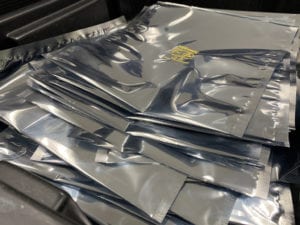What is ESD?
Have you ever walked across carpet and then been zapped by the next thing you touched? That is electrostatic discharge (ESD). It is an event where two charged objects come into contact and causes a quick burst of electricity to be transferred. A person walking across a carpeted floor can generate up to 25,000 volts (25kv), even walking across vinyl tiles can generate and store several thousand volts in your body.
How can ESD affect electronics?
When you generate electrostatic charge and it is discharged into something that is grounded, it will take the path of least resistance to find ground. When the ESD event involves electronics, the charge will run along surfaces looking for a pathway to ground; you don’t know where it’s going to go, and that path could be through some components.
For example, if you have a system that runs off 6 volts and you push 25,000 volts through it there could be damage. The charge running through the system passes components that can’t handle that level of discharge. This may cause an oxide failure that damages the circuitry, the metal to melt, or even cause connections (aka junctions) to breakdown.
When designing electronics, you have two options for protection from ESD:
- Capture it – add an ESD shield – like an antenna that says “hey, look at me” and effectively captures the discharge and directs it away from electronics and into earth ground.
- Avoid it – seal it, create an ESD withstand barrier from circuitry – if you have a large charge built up and then touch a keypad, the charge will start running around the surface looking for a place to ground. If there isn’t a path to take, the charge will just stay in your hand and will discharge when you touch something else. (like your significant other, or a door knob)
Proper handling and storage:
When manufacturing and assembling electronics, it is important to take precautions at each step of the process to prevent any ESD events to occur before the part is fully assembled and ready to be shipped to the customer. Here at Xymox we have several preventive measures in place:
When handling electronic parts, Xymox employees stay grounded
- One way to ensure that any excess charge has a clear path to ground is to wear Anti-Static Wrist Straps (these dissipate charges thus preventing charge from building up in the person handling the electronic parts)
- ESD mats, that are grounded, cover the tabletops in the assembly area
- Parts are stored in ESD protected boxes
- Ionizers hang over work areas and pump out ions to neutralize electrostatic charges (these are tested regularly to ensure they are properly working)
- Products are packaged for shipping in Static Shielding bags (these bags eliminate static build-up and prevent charges from penetrating the bag)

- Maintain humidity levels throughout the factory
Humidity plays a big role
Air conditioning can pull moisture out of the air, causing a greater risk for electrostatic discharges. Air moisture is a natural conductor, so it can absorb and distribute the excess charge. When moisture is pulled out of the air, objects are more likely to hold charges which increases the risk for ESD events to occur. It is common for manufacturing facilities to take steps to maintain a humidity level between 40-60% RH (relative humidity).
In everyday life, ESD events might hurt for a millisecond but we brush it off, it’s not a big deal. In the electronics world, we might not feel it but the electronics do and it’s a big deal. Manufacturing facilities must remain conscious of ESD and actively take steps to prevent it to ensure every single part that is sent to a customer is fully functioning.

